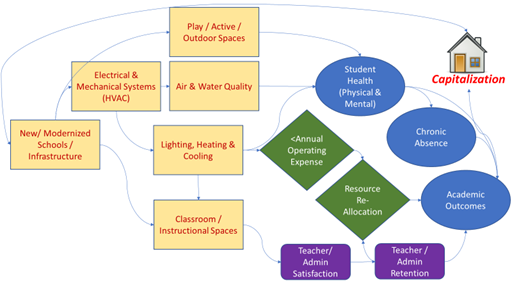School Finance 101: A Few Thoughts on School Funding and Pandemic Relief
I keep getting asked the same questions regarding my thoughts on the current stimulus proposals for schools. So here’s a quick attempt at summarizing my thoughts.
The pandemic has had at least three different types of effects on school funding, which in turn, require specific, separate policy responses.
First, the pandemic has highlighted the need for a short term infusion of resources to make existing schools safer and healthier for existing staff and students, increasing expenses for things such as cleaning supplies, PPE and technology expansion for increased remote access. While these things can add up, they are still probably the smallest among these financial issues facing schools and states in this moment. Still, they must be addressed, both for short term purposes and so that we learn better how to handle similar situations in the future.
The second issue is the fact that the pandemic has created significant shortfalls in state budgets which have yet to be resolved by an appropriately structured federal stimulus package. When state budgets take a hit like this, and income and sales tax revenues dip, there’s usually a large sharp dip for 1 to 3 years, followed by a long slow recovery. We learned a lot from the last great recession. This one is, and will be different in some ways. State budgets and by extension general aid to local school districts will need significant general support for ongoing expenses for the next few years, just to stop the bleeding. But that can’t just go away immediately like it did last time, leaving huge budget holes in year 3 before states had fully recovered. Ongoing district costs, like making sure schools can provide enough nurses, counselors and small enough class sizes require ongoing support. Continued federal aid increases will be needed beyond year 2 or 3 and the federal government must put additional pressure on states to do their part.
We address this issue in these sources:
Baker, B.D., Weber, M., Atchison, D. (2020) Weathering the storm: School funding in the COVID-19 era. Phi Delta Kappan https://kappanonline.org/school-funding-covid-19-baker-weber-atchison/
AND:
https://www.shankerinstitute.org/resource/coronavirus-pandemic-and-k-12-education-funding
Here’s a picture of what a sustained relief package for operating funding shortfalls might look like:

The third issue is that the pandemic has highlighted the extent of inequity in school buildings in terms of safety, health and overall capacity. These have long been issues. Buying more PPE, or having more nurses won’t solve the long accumulated deferred problems of overcrowded, poorly ventilated school buildings that in many cases are over 50 years old. The same facilities also often suffer the greatest deficits in tech infrastructure, while serving communities that have been disproportionately affected by the pandemic.
It’s also important to understand that one factor which limits district ability to reduced class sizes simply by hiring more teachers is lack of useful, quality space. Not enough classrooms! You can’t focus on class size reduction by focusing on personnel alone. Buildings matter.
Schools and districts need renovation, replacement, HVAC upgrades. This may be an especially good use of a large infusion of federal funding, because even after that funding is gone – what was bought with that funding will last for some time. Not only that, but if the federal gov’t invested a large sum in school facilities renewal and environmental improvement (HVAC, lighting, tech.) the ongoing costs of operating those facilities, which falls on districts and states, would actually be reduced. It’s a win-win.
Older post on school facilities and why they matter: https://schoolfinance101.wordpress.com/2019/08/26/school-facilities-matter-in-so-many-ways-how-could-they-not/
And a picture:

The current Biden framework includes some of these elements, but lacks sufficient detail. The plan needs to better sort out the short term (COVID preparedness), medium term (filling state budget holes) and longer term (maintaining adequate ongoing funding and investing in infrastructure) issues. Focusing on hiring teachers to reduce class size sounds good, politically, but there have to be classrooms in which to house these smaller classes.
Further, current conditions faced by districts across the country vary. Some may require more staff. Some may require better paid staff. This problem is broadly solved by an infusion of general aid, not funds targeted specifically toward expenditures that may or may not be top priorities, may be infeasible and may lead to problematic cuts a few years down the line.
Any final regulations on the plan need to make sure that states do their part. That states don’t generally decimate school budgets over the next several years and that states specifically protect the interests of the most vulnerable children and families, both in terms of the formulas by which new federal aid is allocated and the states’ own obligations.
This report provides some ideas of where that money is needed most, now and in the future: https://tcf.org/content/report/closing-americas-education-funding/
This blog post has been shared by permission from the author.
Readers wishing to comment on the content are encouraged to do so via the link to the original post.
Find the original post here:
The views expressed by the blogger are not necessarily those of NEPC.
